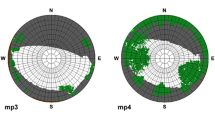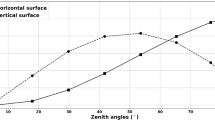Abstract
The mean radiant temperature, Tmrt, which sums up all shortwave and longwave radiation fluxes (both direct and reflected) to which the human body is exposed is one of the key meteorological parameters governing human energy balance and the thermal comfort of man. In this paper, a new radiation model (SOLWEIG 1.0), which simulates spatial variations of 3D radiation fluxes and Tmrt in complex urban settings, is presented. The Tmrt is derived by modelling shortwave and longwave radiation fluxes in six directions (upward, downward and from the four cardinal points) and angular factors. The model requires a limited number of inputs, such as direct, diffuse and global shortwave radiation, air temperature, relative humidity, urban geometry and geographical information (latitude, longitude and elevation). The model was evaluated using 7 days of integral radiation measurements at two sites with different building geometries – a large square and a small courtyard in Göteborg, Sweden (57°N) – across different seasons and in various weather conditions. The evaluation reveals good agreement between modelled and measured values of Tmrt, with an overall good correspondence of R 2 = 0.94, (p < 0.01, RMSE = 4.8 K). SOLWEIG 1.0 is still under development. Future work will incorporate a vegetation scheme, as well as an improvement of the estimation of fluxes from the four cardinal points.












Similar content being viewed by others
References
ASHRAE (2001) ASHRAE Fundamentals Handbook 2001 (SI Edition) American Society of Heating, Refrigerating, and Air-Conditioning Engineers, ISBN: 1883413885
Ali-Toudert F (2005) Dependence of outdoor thermal comfort on street design. Berichte des Meteorologischen Institutes der Universität Freiburg, Frieburg, November 2005, No. 15
Ali-Toudert F, Mayer H (2007) Thermal comfort in an east–west oriented street canyon in Freiburg (Germany) under hot summer conditions. Theor Appl Climatol 87:223–237
Bogren J, Gustavsson T, Karlsson M, Postgård U (2000) The Impact of Screening on Road Surface Temperature. Meteorol Appl 7:97–104
Brown MJ, Grimmond CSB, Ratti CF (2001) Comparison of methodologies for computing sky view factor in urban environments. International society of environmental hydraulics conference. Tempe, AZ December 2001, LA-UR-01–4107
Bruse M (1999) Die Auswirkungen kleinskaliger Umweltgestaltung auf das Mikroklima-Entwicklung des prognostischen numerischen Modells ENVI-met zur Simulation der Wind-, Tempertaur-, und Feuchteverteilung in städtischen Struckturen. PhD Thesis, University Bochum, Germany
Bruse M (2006) ENVI-met website. http://www.envi-met.com
Crawford TM, Duchon CE (1999) An improved parameterization for estimating effective atmospheric emissivity for use in calculating daytime downwelling longwave radiation. J Appl Meteorol 38:474–480
de Dear R (1987) Ping-pong globe thermometers for mean radiant temperatures. Heating Ventilation Eng J Air Conditioning 60:10–11
Duarte HF, Dias NL, Maggiotto SR (2006) Assessing daytime longwave radiation estimates for clear and clowdy skies in Southern Brazil. Agric For Meteorol 139:171–181
Fanger PO (1972) Thermal comfort, analysis and application in environment engineering. McGraw Hill, New York
Gál T, Lindberg F, Unger J (2008) Computing continuous sky view factor using 3D urban raster and vector databases: comparison and an application for urban climate. Theor Appl Climatol, DOI 10.1007/s00704-007-0362-9
Gueymard C (2000) Prediction and performance assessment of mean hourly global radiation. Sol Energy 68:285–303
Holmer B (1992) A method for determination of sky view factors. Meteorol Z NF 1:236–239
Höppe P (1992) A new procedure to determine the mean radiant temperature outdoors. Wetter Leben 44:147–151
Jendritzky G, Menz G, Schirmer H, Schmidt-Kessen W (1990) Methodik zur raumbezogenen Bewertung der thermischen Komponente im Bioklima des Menschen (Fortgeschriebenes Klima-Michel-Modell). Beitr. Akad. Raumforschung und Landesplanung 114, Hannover
Jonsson P, Eliasson I, Holmer B, Grimmond CSB (2006) Longwave incoming radiation in the Tropics: results from field work in three African cities. Theor Appl Climatol 85:185–201
Kuehn LA, Stubbs RA, Weaver RS (1970) Theory of the globe thermometer. J Appl Physiol 29:750–757
Lindberg F (2005) Towards the use of local governmental 3-D data within urban climatology studies. Mapping Image Sci 2:32–37
Lindberg F (2007) Modelling the urban climate using a local governmental geodatabase. Meteorol Appl 14:263–273
Matzarakis A (2000) Estimation and calculation of the mean radiant temperature within urban structures. Manual to RayMan, University of Freiburg, Germany
Matzarakis A, Rutz F, Mayer H (2000) Estimation and calculation of the mean radiant temperature within urban structures. In: de Dear RJ, Kalma JD, Oke TR, Auliciems A (eds.) Biometeorology and Urban Climatology at the Turn of the Millennium. ICB-ICUC’99, Sydney, WCASP-50, WMO/TD No 1026, 273–278
Matzarakis A, Rutz F, Mayer H (2007) Modelling radiation fluxes in simple and complex environments – application of the RayMan model. Int J Biometeorol 51:323–334
Nikolopoulou N, Baker N, Steemers K (1999) Improvements to the globe thermometer for outdoor use. Archit Sci Rev 42:27–34
Nikolopoulou M, Steemers K (2003) Thermal comfort and psychological adaptation as a guide for designing urban spaces. Energy Build 35:95–101
Oke T (1987) Boundary layer climates. Routledge, Cambridge, p 435
Olseth JA, Skartveit A (1993) Characteristics of hourly global irradiance modelled from cloud data. Sol Energy 51:197–204
Pickup J, de Dear R (1999) An outdoor thermal index (OUTSET*)-part1. The model and its assumptions. Proceedings of the 15th International congress biometeorology and international conference on urban climatology, Sydney, Australia, 1999, p279–283
Prata AJ (1996) A new long-wave formula for estimating downward clear-sky radiation at the surface. Q J R Meteorol Soc 122:1127–1151
Ratti CF (2001) Urban analysis for environmental prediction. Darwin College, University of Cambridge
Ratti CF, Richens P (1999) Urban texture analysis with image processing techniques. Proc CAADFutures99. Atlanta, GA.
Reda I, Andreas A (2003) Solar position algorithm for solar radiation applications. National Renewable Energy Laboratory. NREL/TP-560–34302
Roderick ML (1999) Estimating the diffuse component from daily and monthly measurements of global radiation. Agric Forest Meteorol 95:169–185
Teller J, Azar S (2001) TownScope II - A computer system to support solar access decisionmaking. Sol Energy 70:187–200
Thorsson S, Lindberg F, Eliasson I, Holmer B (2006) Measurements of mean radiant temperature in different urban structures. In: Lindqvist, S, Grimmond, CBS, (eds.), 6th International Conference on Urban Climate, 867–870. Urban Climate Group, Department of Geosciences, Göteborg University, Sweden
Thorsson S, Lindberg F, Eliasson I, Holmer B (2007) Different methods for estimating the mean radiant temperature in the outdoor urban setting. Int J Climatol 27(14):s1983–s1993
VDI (1994) Environmental meteorology, interactions between atmosphere and surface; calculation of short-and long wave radiation. Part I: Climate, VDI 3789, Part 2: VDI/DIN- Handbuch Reinhaltung der Luft, Band 1b, Düsseldorf
Vernon HM (1932) The measurement of radiant temperature in relation to human comfort. J Ind Hyg 14:95–111
Acknowledgements
Financial support for this project was provided by FORMAS, the Swedish Research Council for Environment, Agricultural Sciences and Spatial Planning in their key action area Urban Public Places. Thanks to Ingegärd Eliasson and Sven Lindqvist who supervised the project, and to Alexander Walther for programming support.
Author information
Authors and Affiliations
Corresponding author
Rights and permissions
About this article
Cite this article
Lindberg, F., Holmer, B. & Thorsson, S. SOLWEIG 1.0 – Modelling spatial variations of 3D radiant fluxes and mean radiant temperature in complex urban settings. Int J Biometeorol 52, 697–713 (2008). https://doi.org/10.1007/s00484-008-0162-7
Received:
Revised:
Accepted:
Published:
Issue Date:
DOI: https://doi.org/10.1007/s00484-008-0162-7




